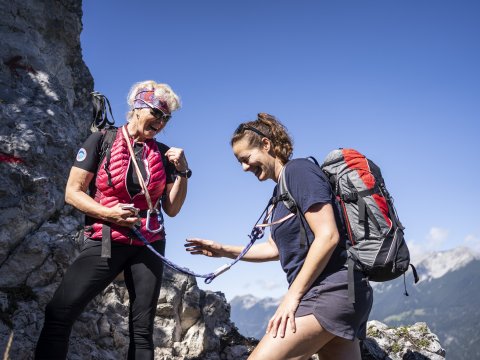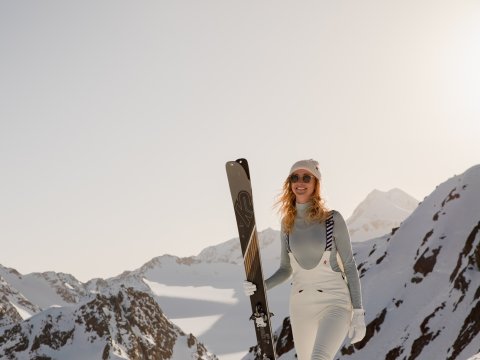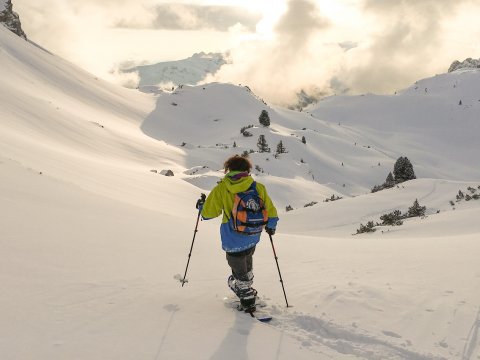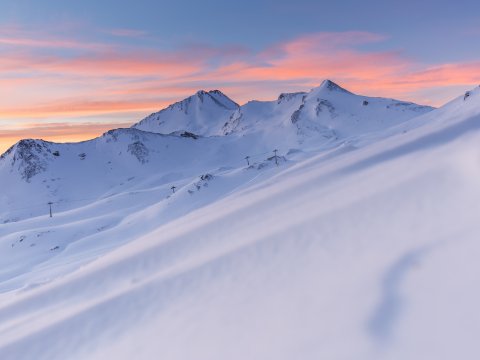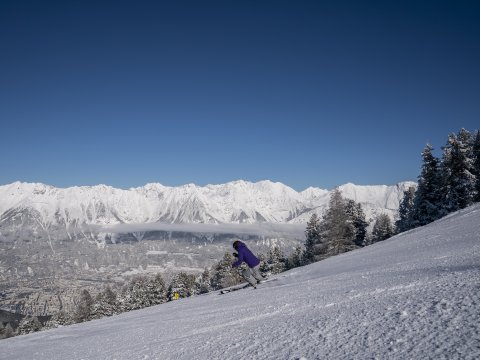Alpine Adventures: My First Time Trail Running
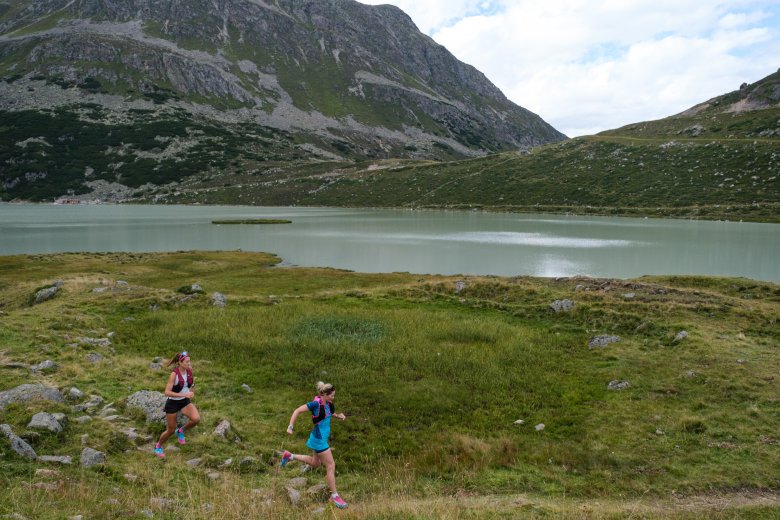
Our author, Andrea, wants to try trail running. Already a keen runner, she is searching for a new sporting challenge. Is it really possible to go running and enjoy the mountains at the same time? Read on to find out.
The first time I came into contact with trail running was by chance. I was preparing for my first marathon and had a 22-kilometre run to do. The problem was that I was on the Greek island of Santorini. It is pretty small and covered in hills, so if you want to get anywhere you have to go up and down, up and down, up and down. And since I didn't always want to run on the flat main road, where the trucks thundered past one after the other, I had no choice but to explore the narrow trails way along the clifftop. They were pretty rocky and almost never flat – a perpetual mix of up uphill and downhill sections demanding sure-footing and total concentration.
I quickly realised that I was anything but well prepared. I had taken far too little to drink – and then it started getting dark. Being on holiday, I hadn’t thought to bring a headlamp with me. All in all it was pretty challenge introduction to the sport. To be honest, I’ve never quite understood the idea behind trail running. Why can’t people just enjoy the mountains? Take their time? Admire the view? Do you really have to turn every hobby into a competition?
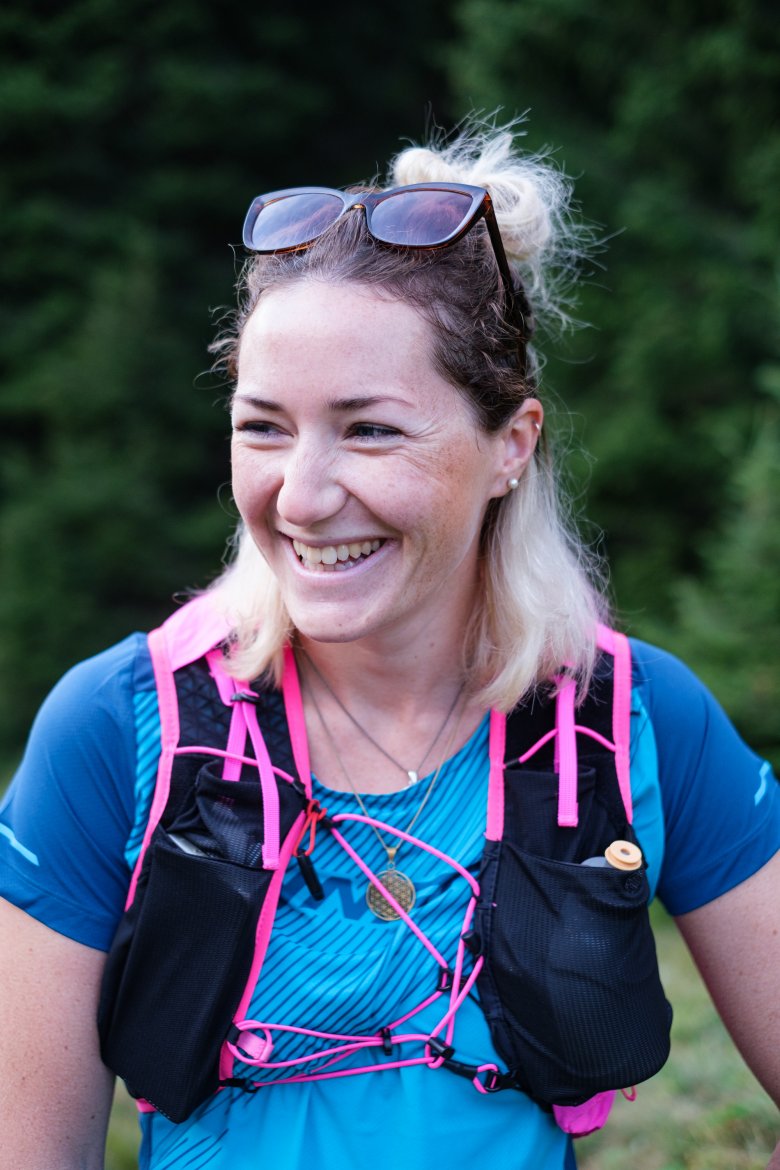
But I also have to admit that, looking back, I did actually quite enjoy my first time trail running on Santorini. It was fun to jump from rock to rock instead of running the same old routes on the same old tarmac again and again. So, after a while, I decided to give trail running a second chance – but this time with enough water, plenty of daylight and, above all, a bit more idea of what I am getting myself into.
My first little bit of internet research immediately revealed a plethora of advantages that trail running is said to offer. Trail running, for example, is supposed to be much better your brain than "normal" jogging. The reason? The ups, downs and challenging trails demand greater concentration. That is something I can definitely identify with from my first experience on Santorini. Check.
I also read that running uphill increases leg strength, that uneven terrain is better for training balance, coordination and stability in the ankles, and that running downhill helps you to become be more sure-footed. That all sounds very plausible to me.
At the end of my internet session I am sure of one thing: it will definitely be more exciting, more varied and more adventurous than my standard run on a dirt track along the riverbank. And, based on what I have read, it will probably also be a better workout for my body. Sounds good. I can’t wait to get started.
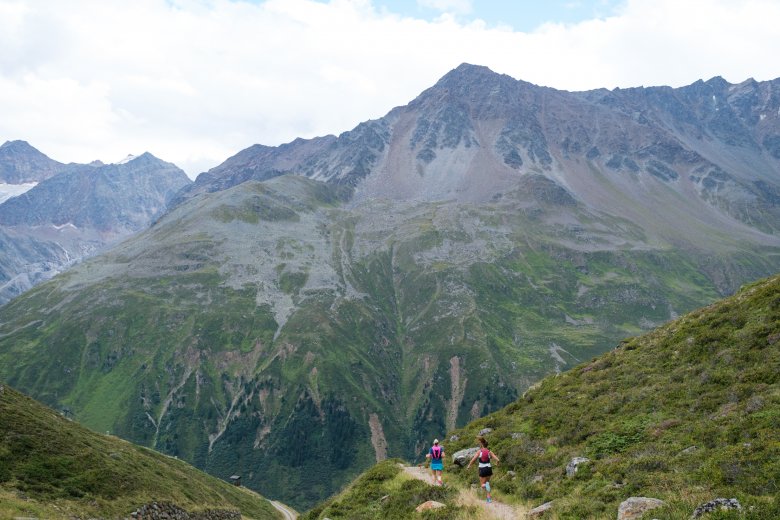
My first attempts in the mountains
I decide to incorporate some trail running elements next time I am in the mountains. I am super motivated as I set off. After a fast start on the flat, the terrain soon gets steeper I am more or less back to walking pace. This is not how I had envisaged my first proper day of trail running. I complete the 835 vertical metres from the valley to the top with a mix of fast walking and slow running. When I get to the summit, I am however pleasantly surprised to find that my time was a lot faster than usual. Sure, this time I have a light trailrun backpack instead of a heavy rucksack, but I am still pretty pleased. I may not have run all the way from bottom to top, but simply the goal of running instead of walking seems to have spurred me on to put one foot in front of the other just that little bit more quickly.
I definitely spent less time than usual looking around. I didn't talk to anyone. And I hardly took any breaks. Still, somehow I had imagined it would be easier and, above all, faster than it was. If I am honest, it doesn’t seem all that different from hiking– just much more strenuous, sweatier and a bit hectic. On the other hand, I'm proud to have completed the ascent in just half the estimated walking time shown to walkers and hikers on the bright yellow signposts.
My initial conclusion is that I am on the right track. Most importantly, it's fun. I was able to switch off and, as I said, was much faster than usual. I had the feeling that it was much smoother than hiking, especially going downhill, because you don't brake at every step but instead go with the flow. And – something I had been worried about before setting out – I found that I could still enjoy the mountains and the view even while running. I have to say, I’m starting to like it. There's something about travelling light and fast in the mountains that appeals to me.
Now, time to find a coach
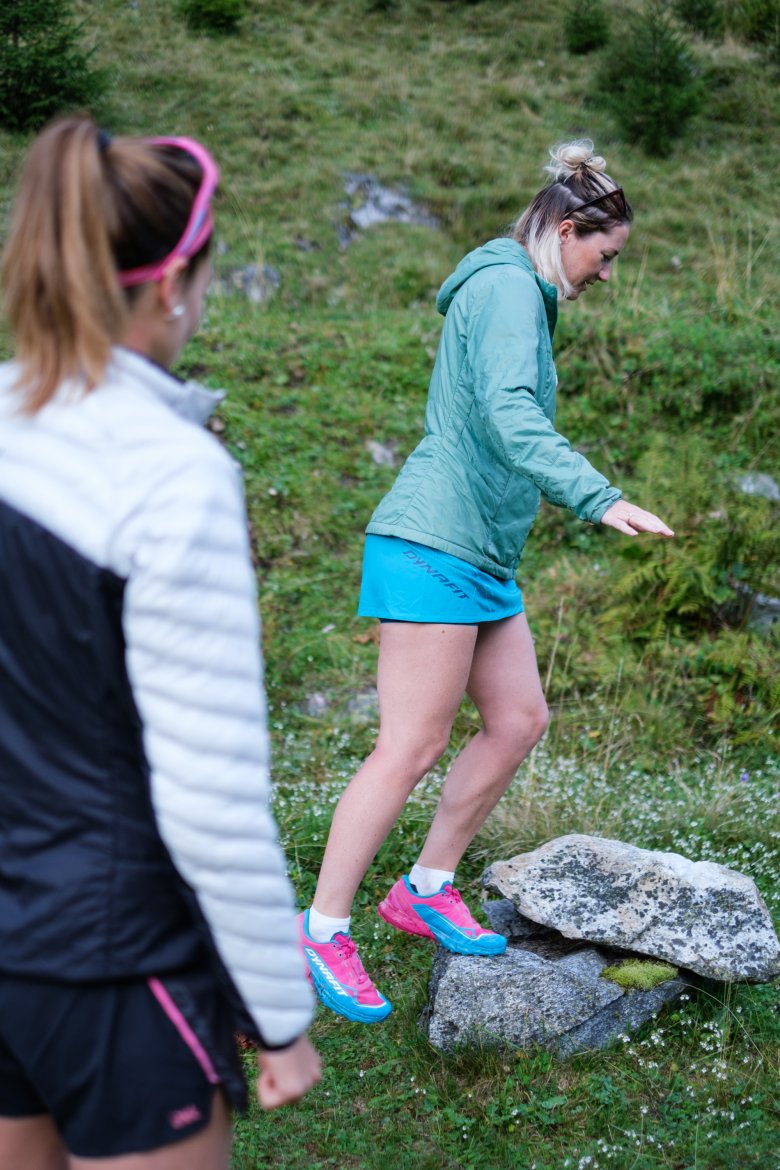
Despite my initial enthusiasm, I know I still have a lot to learn. I decide to look for a coach to give me tips on running technique and training. I turn to Rosanna Buchauer. As a professional trail runner and member of the Dynafit Team, she is the perfect person to help me take my own trail running skills to the next level. What is it, I ask her, that makes trail running so special. "The untouched nature and the silence the sport offers. I often find myself totally alone, because as a trail runner I am much faster than the hikers," says Rosanna. "I also like the fact that I can have a relaxed breakfast at home, head into the mountains, and be back in the afternoon. Walkers and hikers often need the whole day to complete the same route." Okay, so it's not just about speed, but also about the time that you "gain" and the fact that you can enjoy the experience of standing on top of a mountain or stopping for a coffee at a hut, for example, without necessarily having to be out all day.

I have got some new equipment that I am keen to try out with Rosanna. But what is the right trail? I think my first attempts at running in the mountains were just too steep. I couldn't even jog to the top – and that left me feeling frustrated. "I would recommend a short run, not too steep, with a mixture of dirt roads and trails. Run the dirt roads at an easy pace and walk the trails if gets too steep," recommends Rosanna. I check out the area around where I live and discover the Isar Trail. Bingo! It is a good mixture of wide and narrow with plenty of up and down but nothing too steep. And, importantly, it's right on my doorstep. Great for training. And it's good to know that walking is also totally okay. "Most people think we always sprint uphill. That’s so not true. Even the pros walk the steep uphill sections," Rosanna explains. That reassures me. "So start off easy at the beginning. Slow and steady. And don't be afraid to go uphill." I find a perfect route: 9.1 kilometres, 266 vertical metres of downhill and just 169 vertical metres of uphill.
Time to hit the trails
So I load up my new backpack, throw in plenty to drink and a small snack, and stow everything close to my body. Shoes on and off we go! Rosanna also gave me two more tips. Tip one: when running uphill, take very small steps and go slow. Tip two: when jogging downhill, take big leaps and go with the flow.
We start off on a fairly wide forest path. What strikes me immediately is that the path feels so nice and soft under my feet. It really bounces, especially compared to asphalt or gravel. And not only does it feel good, it's also much better for my bones, as I find out at the end of the run.
We reach the first downhill section. The path has become a narrow trail. I jump over roots, then over a tree trunk lying across the path. I duck under branches or hop over a small stream. After a few kilometres I notice once again that I can really switch off because I have to concentrate totally on the terrain. No space for any other thoughts. That feels great. I am happy and almost float along the trail. I notice how I'm getting faster and faster. Especially when going downhill. I'm getting braver and more sure-footed – daring to take bigger steps and jumps. I'm also making good progress uphill. Rosanna's tip with the mini-steps was great. Of course it's much tougher going uphill, and every now and then I have to walk, but then the next downhill section is already waiting for me.
My conclusion after 9 kilometres: wow! It's much more fun than "normal" jogging, very varied and the time seems to go by much faster.

Back home, stretched and showered, my body feels different than after running a few kilometres on the flat. I feel my legs more, but also feel somehow more satisfied – like I have completed a little adventure. I am more proud of what I have achieved. A good feeling.
My positive experience motivates me to keep going. I run several trails – sometimes longer, sometimes steeper, sometimes with even more uphill sections. It feels good and I notice how I am becoming faster and more confident. Something else I notice is that trail running is tough not only on the legs but also on the upper body. That's why I always try to incorporate a few exercises that Rosanna recommended –for example, planks and squats – to improve my upper body strength.
Final run in the Pitztal Valley
So, enough training on my own. I now feel ready for bigger mountains and real alpine trails. For that I meet up with Rosanna in the village of Mandarfen at the end of the Pitztal Valley. This valley is very popular with trail runners, not least thanks to the fact that there are many routes from the valley floor up into the high mountains as well as lots of great huts to stop at and challenging peaks to climb. I have chosen a run with 631 vertical metres of ascent starting at the car park in Mandarfen and leading up to the beautiful Rifflsee lake. After a lap of the lake, we will return along the same route back to the starting point.
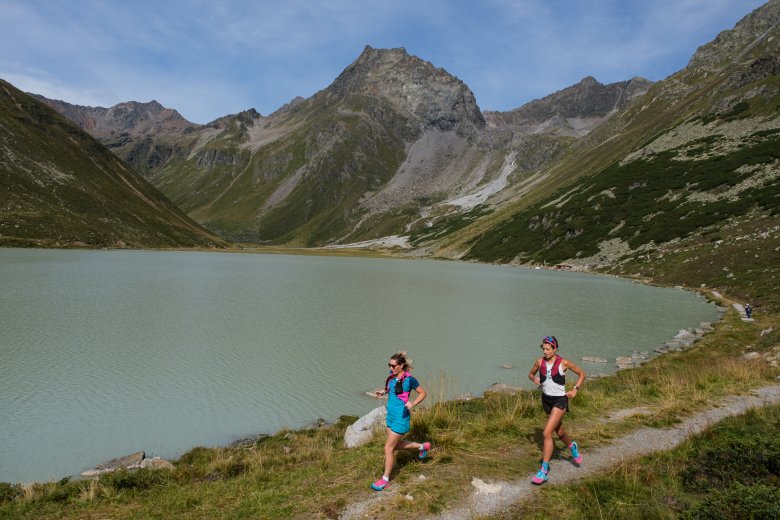
First comes the warm-up. Then Rosanna has a few final tips for me. "If it gets too steep going the uphill, remember to put your hands on your thighs and push to give yourself a bit of extra power," Rosanna explains. "Going downhill, look ahead and take big steps and jumps. I feel like a kid. It’s so much fun." Rosanna always makes it sound so easy. But before I can look forward to big steps and jumps, I have to take on the tough ascent to the lake. "Going up is harder work," Rosanna admits. "It's more of an endurance thing. On the way down it’s more about having the right technique to avoid hurting yourself." The main dangers, she explains, are falling or twisting your ankle. That's why it's important to train well.
As Rosanna said, we start slowly at first. She lets me go first so I can set the pace. The first uphill section goes quite well. I am initially able to maintain a slow jog, but when the trail gets steeper I switch to walking. It is still hard. I’m sweating buckets and in the mood a break after just 15 minutes, but I think to myself: "Let’s push on and get a bit more done. " How does Rosanna manage to struggle up mountain trails like these almost every day? It still seems such a long way to the top. "It's best not to have the summit in sight or as a goal. It's better to think in small steps: to the forest, then to the little hut, then to the lake." Sounds good. On the way up I focus on reaching the next corner, then the next one, then the next one. That way we get higher and higher, bit by bit.
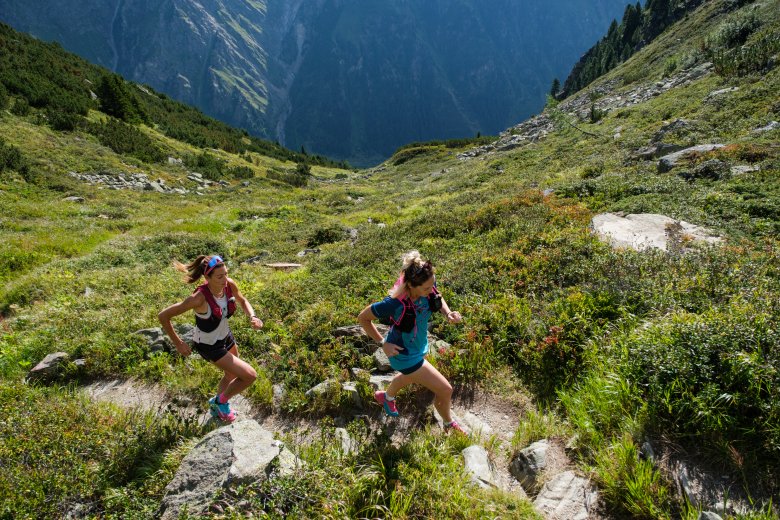
Now, finally, it’s time for a little break. I wolf down an energy bar and have a big slug of my drink. What else does Rosanna have with her? "I always take a thin jacket and a space blanket. It can get cold quickly at the top if you have been sweating. And it’s also really important to have an emergency blanket – if you do get into trouble, it might take a while for the mountain rescue to arrive," Rosanna explains. Crikey. I hope we won't be needing it today, I think to myself, as we slowly set off again.
After a good hour we have made it to the lake. What a view! The sun is shining. It’s just perfect. I'd say we've earned a little break. We have soup and strudel at the hut. For me, it feels like a reward for all that hard work running up here. Rosanna is right –it absolutely is possible to go trail running and also enjoy being in mountains. One way to do so is by planning a route that leads past one of the huts in the area. "Sure, when I'm in a race or doing interval training, I don't stop for a snack or a coffee," says Rosanna. "But I always make sure I plan runs where I do have enough time for a stop at a hut. It’s really important to enjoy the fantastic landscape we are in."
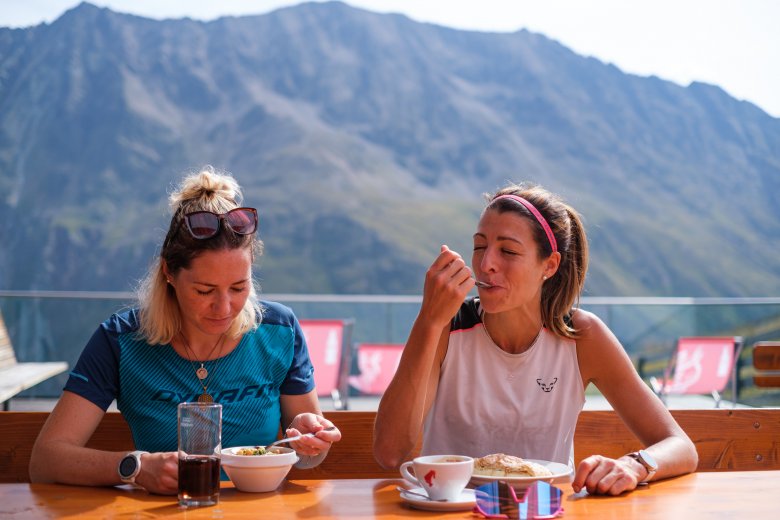
We decide to take it easy on our lap around the Rifflsee lake. It’s such a nice change from all that running uphill. We maintain a good pace but still have time to enjoy the scenery. “Trail running really can be relaxing,” I think to myself as I turn off the flat loop around the lake and begin the descent back down into the valley.
Now the real fun begins! I almost feel like a mountain goat, skillfully jumping from rock to rock. I realise how much more confident I have become. For a moment I think I may have managed to shake off Rosanna, but when I glance over my shoulder she is, of course, right behind me. After 30 minutes of fun-filled descending we arrive back at our starting point.

I'm exhausted – but also exhilarated. I love trail running! The uphill bit was tough, but as the saying goes, what goes up must come down. And for me the view at the top and the thrill of the downhill will always make up for the sweat and strain of the climb.
Let's face it, running on tarmac and dirt roads can be really boring. Trail running, on the other hand, is much more varied and definitely brought out my inner child. Here I could shout "yee-ha" at the top of my voice and jump from rock to rock. When I am out on the trails, I feel at one with nature. I am totally focused on the terrain ahead and nothing else. It’s a great way to switch off and get away from daily life. Tirol has definitely gained one more trail runner. And what about you?











